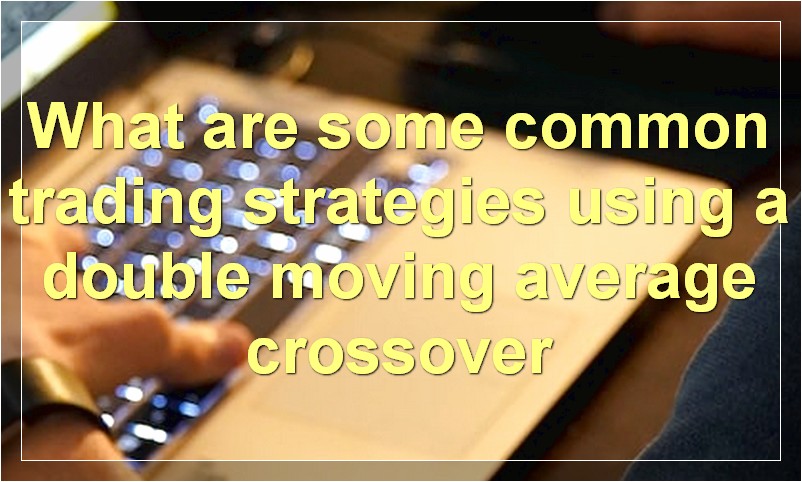and How to Use it in Your Trading}
If you’re looking for a reliable way to make money in the stock market, the double moving average crossover may be just what you need. This tried and true method can help you identify trends and make profitable trades.
What is a double moving average crossover
When it comes to technical analysis, there are a variety of different indicators that traders can use to try and predict future price movement. One popular indicator is the moving average crossover, which is when the price of an asset moves from one side of a moving average to the other.
A double moving average crossover occurs when there are two moving averages involved, and the price crosses both of them. This is generally seen as a stronger signal than a single moving average crossover, as it suggests that the trend is more likely to continue.
There are a number of different ways that traders can choose to use double moving average crossovers, but one common strategy is to buy when the short-term moving average crosses above the long-term moving average, and sell when the reverse happens.
While no indicator is perfect, double moving average crossovers can be a useful tool for traders to add to their arsenal. When used in conjunction with other technical indicators and fundamental analysis, they can help give you a better idea of where the market might be headed next.
What are the benefits of a double moving average crossover

There are numerous benefits to using a double moving average crossover when trading stocks. For starters, it can help to identify trend changes early on, which can give traders a major advantage. Additionally, this strategy can also help to reduce false signals, which can often lead to costly mistakes. Finally, the use of a double moving average crossover can also help to smooth out price action and make it easier to spot potential trading opportunities.
How does a double moving average crossover work
A double moving average crossover is a technical indicator used by traders to signal a possible change in the direction of a security. The double moving average crossover is calculated by taking the difference between two different moving averages of a security’s price. When the shorter-term moving average crosses above the longer-term moving average, it is seen as a bullish signal, indicating that the security’s price may start to rise. Similarly, when the shorter-term moving average crosses below the longer-term moving average, it is seen as a bearish signal, indicating that the security’s price may start to fall.
What are the drawbacks of a double moving average crossover
There are a few potential drawbacks to using a double moving average crossover strategy. First, if the market is in a strong trend, the moving averages may stay far apart and generate false signals. Second, crossovers can be late, especially in choppy markets. Finally, moving averages are lagging indicators, so they will always be behind the current price action.
How do I choose the best moving averages for a double moving average crossover
There is no one “best” moving average for a double moving average crossover system. The two moving averages that are used can be based on different timeframes, such as a long-term and a short-term moving average. The most important thing is to ensure that the moving averages are based on different timeframes so that the crossover signals are more reliable.
What are some common trading strategies using a double moving average crossover

The double moving average crossover is a popular trading strategy that uses two moving averages (MAs) to buy or sell an asset. The strategy is simple: when the faster MA crosses above the slower MA, it’s a buy signal, and when the faster MA crosses below the slower MA, it’s a sell signal.
This strategy can be used on any timeframe, but MAs of different lengths are used for different timeframes. For example, a 10-day MA and a 30-day MA would be used on a daily chart, while a 50-day MA and a 200-day MA would be used on a weekly chart.
The double moving average crossover is a trend-following strategy, so it works best in markets that are trending. It can also work in choppy or range-bound markets, but the signals will be less reliable.
There are many different ways to use the double moving average crossover, but one of the most common is to combine it with other technical indicators. For example, many traders will only take buy signals when the RSI (relative strength index) is above 50 or sell signals when the RSI is below 50. This helps to filter out some of the false signals that can occur in choppy markets.
Another common way to use the double moving average crossover is to wait for a “confirmation” signal before taking a trade. For example, some traders will only take a buy signal if the 50-day MA crosses above the 200-day MA. This type of confirmation can help to avoid false signals and whipsaws (rapid price movements in opposite directions).
There are many different ways to trade using the double moving average crossover, so it’s important to test different strategies and find one that works best for you.
How do I interpret a double moving average crossover
When it comes to technical analysis, there are a lot of different indicators that can be used in order to try and predict future price movement. One of these indicators is the double moving average crossover.
So, how do you interpret a double moving average crossover? Well, there are a few things that you need to look at.
First of all, you need to identify the two moving averages that are crossing over. The most common timeframes for this indicator are the 50-day and 200-day moving averages. However, you can use any timeframe that you want.
Once you have identified the two moving averages, you need to see where they are crossing over. If the 50-day moving average is crossing above the 200-day moving average, then this is seen as a bullish signal. This means that the short-term trend is starting to turn up and that prices could potentially continue to move higher.
On the other hand, if the 50-day moving average is crossing below the 200-day moving average, then this is seen as a bearish signal. This means that the short-term trend is starting to turn down and prices could potentially start to fall.
So, those are just a few things to keep in mind when interpreting a double moving average crossover. Just remember to look at the direction of the crossover and the timeframes involved in order to get a better idea of what it might mean for price action going forward.
What are some common pitfalls when using a double moving average crossover
There are a few common pitfalls when using a double moving average crossover. Firstly, many traders use too short of a time frame, which can lead to false signals. Secondly, some traders use the crossover as a buy or sell signal without considering the underlying trend. Finally, many traders don’t put enough weight on recent price action and overlook important support and resistance levels.
How can I improve my results with a double moving average crossover
When it comes to improving your results with a double moving average crossover, there are a few key things you can do. First, make sure that you are using quality data. This means using data that is free of errors and is from a reliable source. Second, use a longer time frame for your moving averages. This will help to smooth out the data and give you a better picture of the overall trend. Finally, be patient and wait for clear signals. Don’t enter into a trade just because the moving averages have crossed. Wait for confirmation from other indicators or price action before entering into a position.
What are some advanced techniques for using a double moving average crossover
The double moving average crossover is a technical indicator that is used to signal buy and sell signals for traders. The indicator is created by taking two moving averages of different lengths and then plotting them on a chart. When the shorter moving average crosses above the longer moving average, it is considered a buy signal. Conversely, when the shorter moving average crosses below the longer moving average, it is considered a sell signal. The key with using this indicator is to use different lengths for the moving averages in order to avoid false signals.

